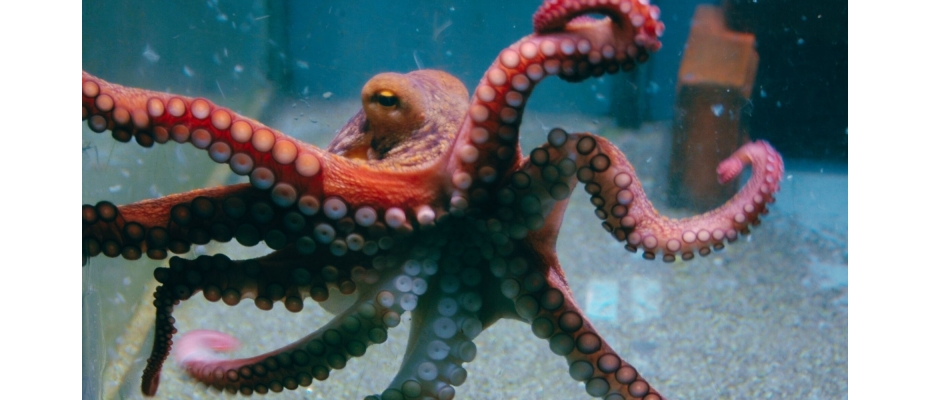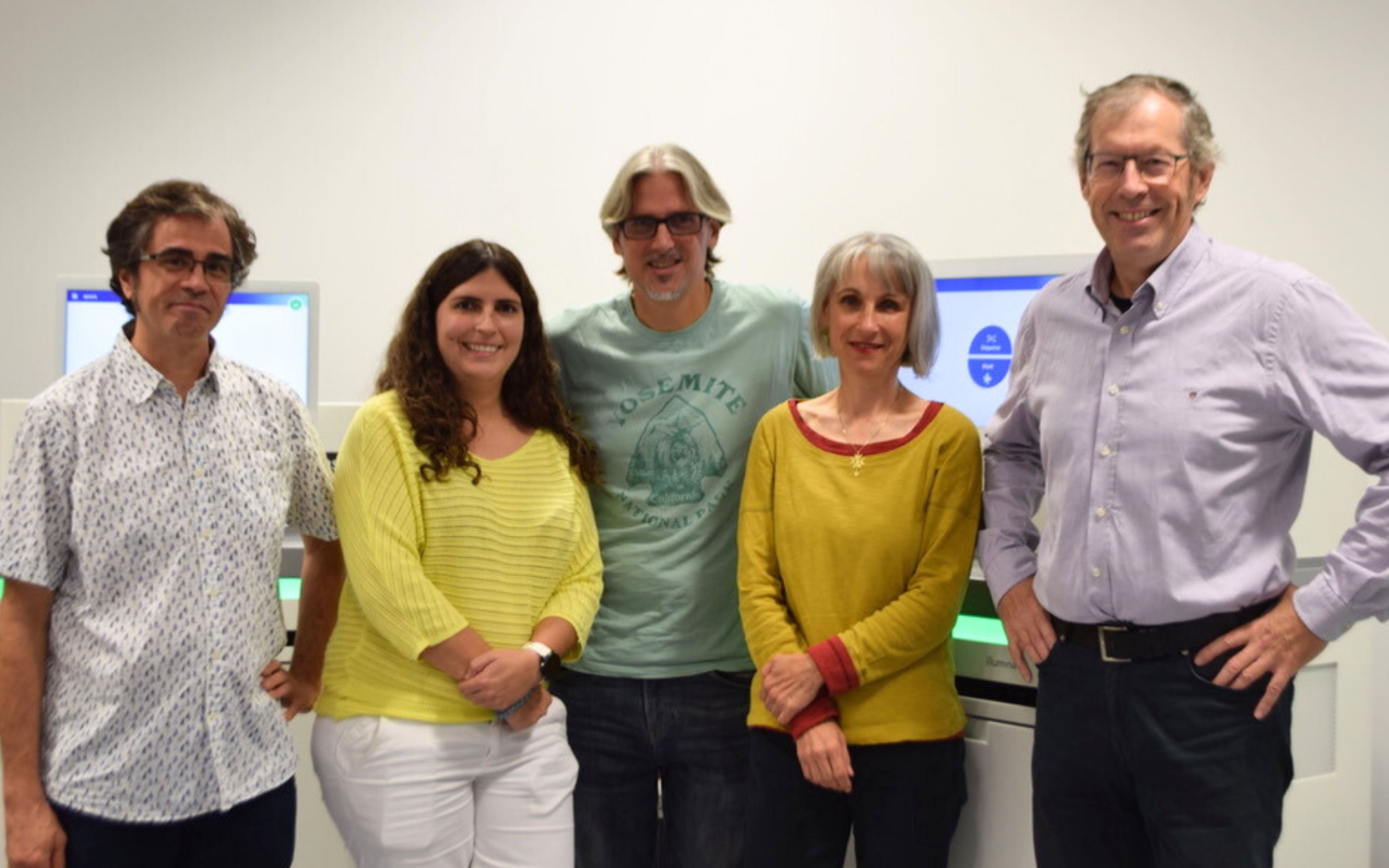
The Centro Nacional de Análisis Genómico (CNAG) has significantly contributed to the international study, performing Whole Genome Sequencing (WGS), the genome assembly and annotation.
The research, ‘A chromosome-level reference genome for the common octopus, Octopus vulgaris (Cuvier, 1797)’ has been published in the journal G3: Genes, Genomes, Genetics.
The study was born in the framework of the international project EASI-Genomics, whose objective is to provide DNA Sequencing technologies to researchers from academia and industry.
October 19, 2023. The word ‘cephalopods’ refers to all those marine species whose heads are literally connected to their limbs, including the squids, octopus, cuttlefish and nautilus. In some cases, their size can be very impressive, reaching a length of more than 20 meters. However, what really makes a cephalopod most unique is its nervous system, the largest among invertebrates in the case of coleoid cephalopods which comprise about 800 species. They are capable of such sophisticated behaviors as collecting information from their environment to adapt their color or shape or even handling tools to their advantage. Precisely because of their complex nervous system, their advanced learning abilities and their exceptional camouflage abilities there was the imperative to go one step further and offer the scientific community the chromosome-scale genome assembly for the common octopus, Octopus vulgaris (Cuvier, 1797), not available until now.
This was the main objective of the international research, promoted by Dr. Eve Seuntjens (KU Leuven, Belgium), Dr. Oleg Simakov (the University of Vienna, Austria), Dr. Graziano Fiorito and Dr. Giovanna Ponte (Stazione Zoologica Anton Dohrn. Italy), in close collaboration with the Sequencing Unit led by Dr. Marta Gut and the Genome Assembly and Annotation Team led by Dr. Tyler Alioto from the Centro Nacional de Análisis Genómico (CNAG, Spain). The study, which have been published in the journal G3: Genes, Genomes, Genetics, was funded by the international project EASI-Genomics, a collaborative initiative coordinated by Ivo Gut (the director of CNAG) whose objective is to provide DNA sequencing technologies to researchers from academia and industry. One of the most important contributions of the study has been the opportunity to discover more about how the brain works, from studying the neural plasticity of cephalopod brains.
According to Ivo Gut, the coordinator of EASI-Genomics: “It is very gratifying to see a challenging project like this one reach such an impressive outcome. The boundaries of what is possible with genome technologies in terms of dealing with a very complicated genomes have once more been moved. It also highlights the need for close collaboration of researchers trying to push the envelope and the extremely high-tech operations of centers such as the CNAG”.
23.000 genes, decoded in Spain by the most state-of-the-art genomic technologies

At CNAG, the Sequencing Unit and the Genome Assembly and Annotation Team contributed significantly to the study, performing WGS Sequencing using state-of-the-art genomics technologies, such as from Illumina, Oxford Nanopore Technologies and 10X Genomics, and applying chromatin contacts to achieve a chromosome level genome assembly.
According to the researcher from CNAG, Dr. Tyler Alioto: “Assembling the thirty chromosomes of the common octopus genome and its over 23,000 genes, was greatly facilitated by using a combination of new DNA sequencing technology capable of reading very long fragments of DNA at once and a complementary sequencing method capable of grouping the assembled sequences into chromosomes. This genome presented an unprecedented computational challenge, due to the complexity of the underlying genome, but we are really satisfied with the final results”.
A new available genetic map, a model also for mammalian species
The result of the research has been a complete success, shedding light on the previous genomes studies, especially valuable in characterizing the cellular diversity of the developing brain, the evolution of cephalopod brains and the non-coding RNA repertoire unique to cephalopods. The assembly contains 2.8 billion basepairs, 99,34% of which are in 30 chromosomes. The annotation of the common octopus comprises 23,423 protein-coding genes composed of 31,799 transcripts. For reference only, the human genome contains 20.000 genes., in 23 chromosomes.
In addition to become an important emerging model for future evolutionary studies of cephalopods, the chromosome-level genome of the Octopus vulgaris will be a breakthrough in comparative neuroscience, cognition research and developmental biology. The scientific community will have another tool available to further study of the nervous, learning and memory system, not only in the field of cephalopods but also in the mammalian species.
In fact, this specie is so fascinating, particularly in the scientific field, that the studies of these animals looks back on a long tradition, especially since the neuronal plasticity of the octopus brain – meaning the brain's ability to change and adapt as you learn and experience new things – provides evidence for the existence of functionally analogous structures to the brains of mammals. This is making them also a comparative model group for neurophysiological studies. On the other hand, their ability to regenerate parts of their bodies as well as the rapid changes of their body patterns, which are important for camouflage and communication, make octopuses a popular research subject for studying how these innovative traits arose – and how they have changed – during evolution.
Dr. Eve Seuntjens, main author of the study and principal investigator of the Lab of Developmental Neurobiology, Animal Physiology and Neurobiology Division (Department of Biology, KU Leuven), highlights the following: “The fact that we could place more than 99% of the basepairs on chromosomal scaffolds is an immense step forward and will boost molecular analysis of this animal”.
Reference article:
Dalila Destanovic et al., ‘A chromosome-level reference genome for the common octopus, Octopus vulgaris (Cuvier, 1797)’. October, 2023. DOI: https://doi.org/10.1093/g3journal/jkad220










